On February 21, 2015, Caroline (Caro) North and Christina Huber (AU) reached the summit of 10,262-foot Cerro Torre via the Ragni Route (M4 90 degrees, 600m), marking the first all-female team ascent, done free and unsupported, of the Patagonian tower. (In 2005, Monika Kambic and Tanja Grmovsek climbed the mountain’s Compressor Route; Kambic was hit by falling ice on the headwall, and the two women jumared a rope that had been fixed over the crux pitch by another party to reach the summit.) Two years prior, North had attempted the West Face with French climber Laure Batoz but was forced to turn around just two pitches below the top. “Since then, the mountain stayed in my mind, and the motivation was big to go back to reach its mushroom summit,” says North. That year was her first season in Patagonia, and she had never thought about climbing Cerro Torre until talking with Dorte Pietron (DE), who had made the first female ascent of the Ragni Route in 2008.
When North returned to Patagonia in 2014, unsettled weather kept her away from the mountain. This year she teamed up with Christina Huber, who had three weeks to spare for the trip. They took advantage of a weather window that opened for only a few days after they arrived, and reached the summit under rare clear and calm conditions.
“During our climb, we weren’t thinking at all about the first female ascent; we were just enjoying the climb, which was awesome, because it is definitely one of the best ice routes, probably even the best, I’ve ever climbed!” says North.
Below is a photo gallery of their climb. –Courtney Ley
[Photo] Caro North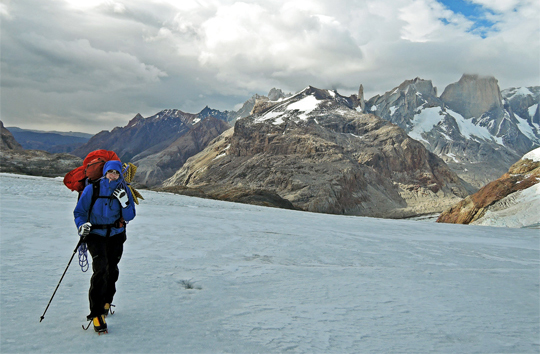
A few days after arriving in Patagonia, Christina Huber and Caro North headed up to Paso Marconi in the afternoon, camping below the glacier. Huber, crossing a snowfield, hoped that luck and good weather would let them climb Cerro Torre before she had to head back to Austria for her studies. The pair planned a three-day approach, which allowed them to camp below the Elmo on the third night before tackling the peak.
[Photo] Caro North
Christina Huber takes a break at Circulo de los Altares below the Cerro Torre massif under calm, clear skies. The upper part of the Ragni Route follows the upper right ridge of Cerro Torre. Caro North described the scenery here as “flat, and everything is white. But walking there on this great day was awesome. We stopped once to melt snow to drink. The backpacks were really heavy, and our backs hurt after awhile, so we started switching the ropes around. I was happy to walk with music.”
[Photo] Luka Lindic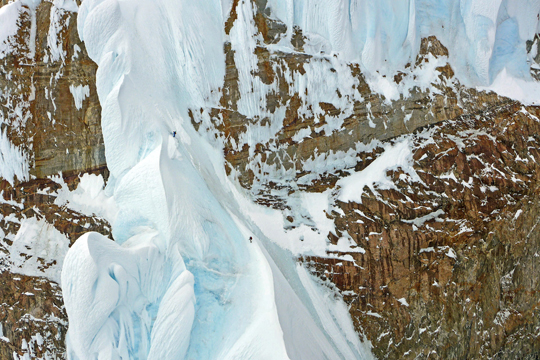
On the third day, North and Huber climb rock slabs where they belayed on a tricky part, then up snow and ice to the Col de la Esperanza, a notched pass on the south side of Cerro Torre. “Easy climbing, but tiring with big backpacks,” says North. At the col, they are surprised to meet three climbers rappelling–their Slovenian friends Luka Krajnc, Luka Lindic and Tadej Kriselj, who had just climbed the Adela Traverse and were on their way to the bivouac below the Elmo. (The Slovene trio also climbed the Ragni to the top of Cerro Torre the same day as North and Huber.) North wrote on the Mammut website: “We can take off our shoes there and rest inside these bizarre formations. The [Slovenians] have brought music to improve the atmosphere. It all feels a bit unreal.”
[Photo] Luka Lindic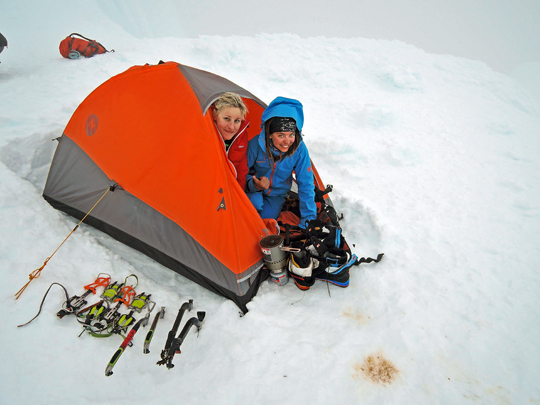
Huber and North enjoying their bivouac at the Elmo. After climbing most of the day, they arrived at the Elmo around 4 p.m. They slept until 2:30 a.m. that night and started climbing toward Cerro Torre’s summit at 4:00 a.m.
[Photo] Christina Huber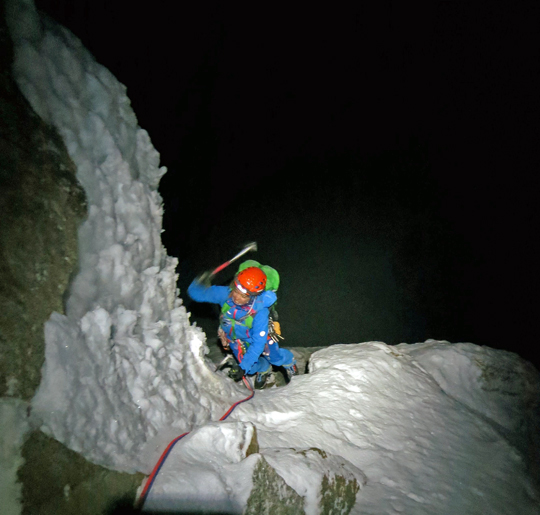
Leaving in the darkness before dawn, North and Huber began their summit bid. “We were moving quite fast, and start climbing the mixed pitches without light. It makes it easier since I already know this part of the route, and so orientation is not a problem,” recalls North.
[Photo] Caro North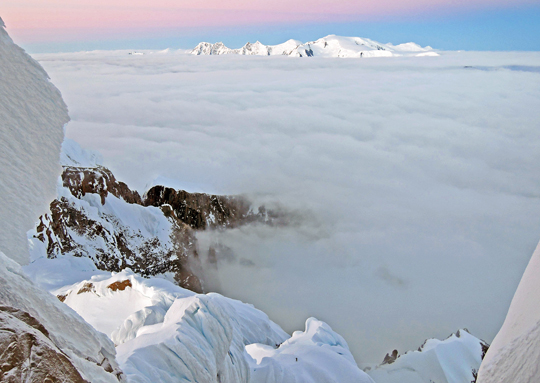
North is familiar with this stretch, having climbed it two years before, so they have no route-finding problems. The sky slowly lightens and turns pink and orange, giving a wonderful view. A sea of clouds, pierced only by island-like mountains, surrounds their lofty vantage point. As the sun rises, the shadow of Cerro Torre, framed by a halo, is cast on the cloudy canvas below. North says, “It’s truly a magical sight.”
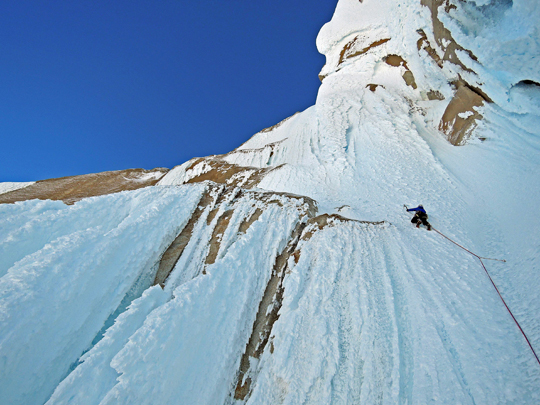
Switching leads, the climbers fall into an easy rhythm up ice pitches and soon reach the headwall, the steepest part of the route, which is climbed in one-and-a-half ropelengths of vertical ice. Christina Huber makes an impressive lead: “I follow with increasingly aching arms,” says North. “We are both grinning broadly when I reach her on the standing point.”
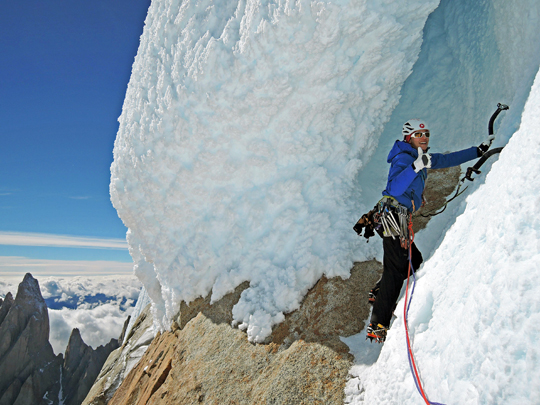
Caro North, at a belay stance that was her high point two years ago, takes a photograph of Huber entering the spectacular ice tunnel on the pitch that passes the second snow mushroom. After exiting the tunnel, they perch one pitch below the summit, with nearly 2,000 feet of still air filling the cirque beneath them. The usual Patagonia winds are not blowing. From this aerie, the last pitch rises impressively above, but first they must traverse a steep, exposed ice slope.
[Photo] Christina Huber
On the final pitch, North carefully works up ice that transitions into steep, loose snow that bulges and overhangs the belay. Luck is on their side: the long pitch has already been climbed this year, and North finds steps from previous climbers that allow her to move up easily. North describes the climbing: “Swinging my pick, I carefully advance meter by meter through this delicate snow. I find some ice eight meters later and put in [a screw]. It’s not great, but it helps me mentally. Bit by bit, I work my way up until I finally reach the tunnel where I can wedge in.” North brings Huber up, and the pair find themselves standing on the highest snow mushroom–the summit of Cerro Torre.
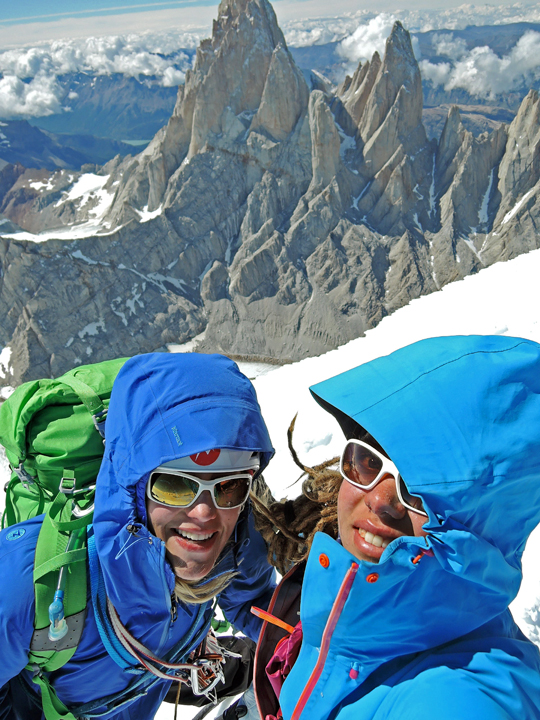
After ten hours of continuous climbing, Caroline North and Christina Huber become the first all-women’s team to make a free, unsupported ascent of Cerro Torre. The pair basks in sunshine on the summit. North says, “We have a free view of the entire massif. Far, far back, we can spot El Chalten. It is exhilarating, but we haven’t forgotten that we are in for a long descent.” They eat a snack and begin rappelling. At the Elmo, they melt snow and drink, then continue down to the col and Circulo de los Altares, which they reach after midnight.
They sleep an hour and, remembering the forecast, which calls for increasing wind, set off again in the dark. The wind grows stronger so they decide to return over Paso del Viento with the wind at their backs, but get lost. “It’s growing late,” says North, “and we are losing time. At times, the wind gets so strong that we are unable to walk against it or stumble sideways. Fear creeps up on us.” Finally, they find the way and head through wind and darkness back to El Chalten. After a 20-hour hike with one hour of sleep, they reach the village just after 1 a.m. North says, “We’re very tired, but content and happy: We have made our great dream come true!”